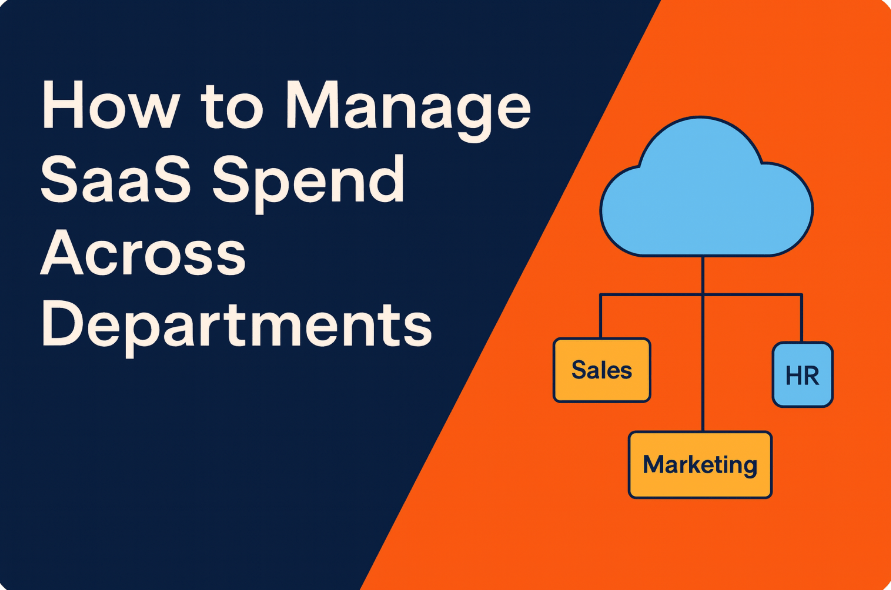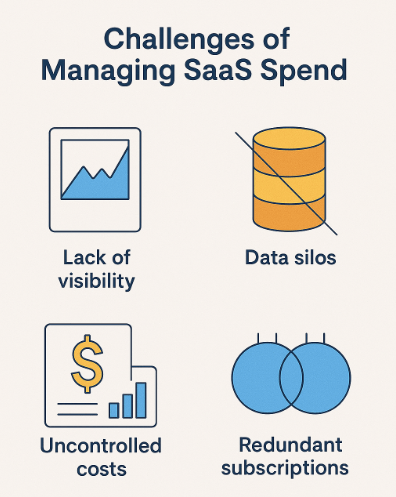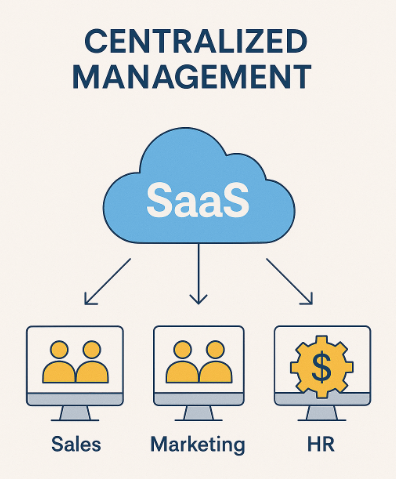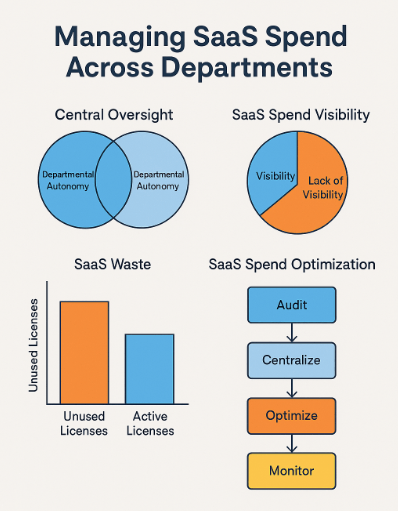
Introduction
The way companies buy and use software has changed dramatically over the past decade. Instead of investing in large, one-time software installations, organizations increasingly rely on Software-as-a-Service (SaaS) applications. From project management tools and CRMs to cloud storage and team communication platforms, SaaS has become the backbone of modern business operations.
But with this convenience comes a new set of financial challenges. Unlike traditional software with predictable, upfront costs, SaaS is subscription-based. Departments can purchase tools independently with just a credit card, bypassing IT and finance teams altogether. While this makes it easy to adopt the latest innovations, it also leads to uncontrolled spending, duplicate subscriptions, and significant budget waste.
Managing SaaS spend across departments isn’t just about cutting costs. It’s about striking a balance between enabling teams to access the tools they need and ensuring the organization doesn’t overspend or lose track of where its money is going. In this article, we’ll explore the challenges of cross-departmental SaaS spend management, outline strategies to control costs, and highlight best practices that help companies maximize value from their software investments.
The Rise of SaaS and Its Financial Impact
SaaS Growth in Organizations
SaaS adoption has skyrocketed because it’s flexible, scalable, and requires little upfront investment. According to industry reports, the average mid-sized company now uses over 200 SaaS applications across departments. Marketing teams rely on analytics platforms, sales teams use CRMs, HR departments use recruitment software, and IT manages cloud infrastructure tools. Each department sees SaaS as an enabler of productivity and innovation.
Benefits vs. Cost Sprawl
The subscription-based model has many advantages:
- Scalability: Businesses can add or remove licenses as teams grow or shrink.
- Low entry barrier: Minimal setup and infrastructure costs make it easy to get started.
- Continuous updates: SaaS vendors push automatic updates, ensuring teams always have the latest features.
However, these same benefits often create cost sprawl. Because SaaS apps are easy to purchase, multiple departments may sign up for the same tool separately. Teams might abandon one tool for another without canceling the original subscription, leaving unused licenses that quietly drain budgets.
The Hidden Waste of SaaS Spending
Research suggests that 30–40% of SaaS licenses go unused within enterprises. Shadow IT—applications purchased without IT approval—further complicates matters by introducing security and compliance risks. Finance leaders often discover SaaS overspending only when reviewing annual expenses, long after the money has been wasted.
When SaaS spend grows unchecked, organizations lose the ability to plan budgets accurately, negotiate vendor discounts, or align purchases with overall business objectives. This makes centralized visibility and management not just beneficial, but essential.
Challenges of Managing SaaS Spend Across Departments
SaaS spend management becomes complicated when multiple departments independently choose, purchase, and manage their tools. While the intention is usually good—teams want to be productive and agile—the result is often overspending, inefficiencies, and compliance risks. Below are the most common challenges organizations face.
1. Lack of Central Visibility
When each department buys SaaS apps separately, finance and IT lose a clear picture of what’s being used and how much is being spent. Without centralized oversight, leadership can’t answer basic questions like:
- How many SaaS applications are in use across the company?
- Which vendors are we paying, and how much per year?
- Are all licenses being actively used?
This visibility gap makes it nearly impossible to optimize costs or negotiate favorable vendor contracts.
2. Duplicate or Redundant Subscriptions
It’s common for different teams to buy the same software without realizing it. For example, both the marketing and product teams might separately purchase a project management tool like Asana, or the HR and finance teams could each have accounts for digital signature platforms. These redundant subscriptions not only waste money but also create silos of data and workflows.
3. Unused or Underutilized Licenses
A recurring issue with SaaS is license underutilization. Companies often pay for “seats” that go unused due to employee turnover, role changes, or shifting tool preferences. Even active licenses might be underutilized if employees only use a fraction of the tool’s features, effectively paying for functionality they don’t need.
4. Shadow IT and Unauthorized Purchases
Shadow IT refers to applications purchased and used without approval from IT or finance. While it allows teams to move fast, it introduces several risks:
- Security: Apps without proper vetting may not comply with data protection policies.
- Compliance: Sensitive data may be stored in systems that don’t meet regulatory requirements.
- Cost control: Untracked subscriptions inflate budgets without accountability.
5. Conflicting Departmental Priorities
Different teams have different goals, which can create tension around SaaS spend:
- Marketing may prioritize innovative tools to stay competitive.
- Finance wants predictability and cost savings.
- IT focuses on security, integration, and scalability.
Without alignment, departments can end up pulling in different directions, leading to fragmented decision-making and budget disputes.
6. Complex Vendor Pricing Models
SaaS vendors use diverse pricing strategies—per user, per feature, per usage volume, or hybrid models. Departments may not fully understand these models, leading to overspending. For example, a CRM with tiered pricing may lock a department into a higher plan when a smaller one would suffice. Similarly, auto-renewals can trap organizations into paying for another year of service without actively assessing value.

Key Principles of Effective SaaS Spend Management
Before diving into tactical steps, organizations need a clear framework that guides how SaaS should be purchased, managed, and optimized across departments. These principles act as the foundation for sustainable cost control and cross-departmental alignment.
1. Balance Centralization with Departmental Autonomy
SaaS management works best when companies strike a balance between central oversight and departmental freedom.
- Too much centralization: slows down innovation and frustrates teams.
- Too much autonomy: leads to duplication, wasted spend, and security risks.
The ideal model allows departments to choose tools that meet their needs while following standardized procurement, budgeting, and security policies set at the organizational level.
2. Ensure Transparency and Visibility
Visibility is the backbone of spend management. Companies must know:
- Which apps are in use.
- How much each department is spending.
- Who owns each subscription.
- How actively tools are being used.
Without this transparency, financial planning and optimization become guesswork. A centralized SaaS inventory or management platform is often the best way to achieve this.
3. Optimize Based on Usage, Not Just Cost
Cutting spend blindly isn’t effective. A tool that looks expensive on paper may actually deliver strong ROI if it’s heavily used and tied to core business outcomes. On the other hand, a cheaper tool might still be wasteful if it’s barely used.
The principle here is rightsizing—aligning the number and type of licenses with real usage patterns. Regular usage monitoring ensures that every dollar spent corresponds to measurable value.
4. Establish Governance and Accountability
Governance ensures that SaaS spend isn’t left to chance. Clear rules should cover:
- Who can approve purchases.
- How renewals are handled.
- Which departments own budgets for specific tools.
- How compliance and security are checked before onboarding new vendors.
Accountability is equally important. Every subscription should have an owner who is responsible for monitoring usage, ensuring adoption, and justifying renewals.
5. Standardize Processes Across the Organization
Inconsistent processes lead to inefficiency. To manage SaaS effectively, organizations should standardize:
- Procurement workflows: define steps for evaluating, purchasing, and approving SaaS.
- Renewal management: set reminders and review cycles well before contracts auto-renew.
- Vendor evaluation: use a common checklist for security, compliance, and integration compatibility.
Standardization not only reduces waste but also strengthens negotiation power with vendors.
6. Align SaaS Strategy with Business Objectives
Finally, SaaS spend management should not exist in isolation. Every purchase must support larger business goals such as growth, efficiency, compliance, or innovation. By tying SaaS investments directly to KPIs and objectives, leadership can ensure that software supports—not undermines—the company’s strategy.

Step-by-Step Strategy to Manage SaaS Spend Across Departments
Managing SaaS spend isn’t just about cutting costs; it’s about building a repeatable system that ensures efficiency, security, and alignment with business goals. Below is a seven-step roadmap that organizations can follow to bring order to SaaS chaos.
Step 1: Conduct a Comprehensive SaaS Audit
Before you can control spend, you need to understand the current state of SaaS usage. A SaaS audit helps answer:
- What applications are currently in use?
- Which departments own them?
- How much are we paying per license, per month, and annually?
- Are there any overlapping or redundant tools?
Methods for auditing:
- Expense reports: Review corporate credit card statements for recurring charges.
- Employee surveys: Ask teams what tools they use regularly.
- Automated discovery tools: SaaS management platforms can automatically detect applications based on login activity and financial records.
The goal of this step is to create a single source of truth—a centralized SaaS inventory.
Step 2: Centralize Vendor and Contract Management
Once you know what SaaS apps are being used, centralize information about contracts, renewal dates, and vendor contacts. Without this step, auto-renewals often slip through unnoticed, leading to unnecessary spend.
Best practices:
- Store all contracts in a shared repository.
- Track renewal dates with automated alerts at least 90 days in advance.
- Consolidate vendors where possible (e.g., one contract for Slack company-wide instead of multiple departmental accounts).
Centralization doesn’t mean eliminating departmental choice; it means ensuring that purchases are coordinated and visible to finance and IT.
Step 3: Create a Cross-Departmental Governance Team
To manage SaaS effectively across departments, form a governance team that includes representatives from:
- IT: Ensures integration, security, and compliance.
- Finance: Tracks budgets, spending patterns, and ROI.
- Department leaders: Provide input on functional needs and adoption.
This team’s role is to:
- Approve new SaaS purchases.
- Review renewal justifications.
- Enforce standardized procurement processes.
- Balance innovation with cost efficiency.
Governance doesn’t have to mean bureaucracy. A lightweight committee that meets monthly or quarterly can provide oversight without slowing down the business.
Step 4: Set Budget Ownership and Accountability Rules
Ambiguity over who owns SaaS spend often leads to finger-pointing and wasted money. Each subscription should have a designated owner—typically the department head or project leader who requested the tool.
Clear rules to establish:
- Who approves SaaS spend requests.
- Which budget (IT vs. department) covers specific tools.
- How costs are allocated when multiple departments share a tool.
Ownership ensures accountability. If a department wants to renew a tool, it must demonstrate usage, adoption, and business value.
Step 5: Standardize Procurement and Renewal Processes
SaaS purchases should never be made casually with a corporate card. Establish a standard procurement workflow to streamline buying and renewal decisions.
Suggested process:
- Department submits request with justification (use case, expected ROI).
- IT evaluates security, integration, and compliance.
- Finance reviews pricing and budget impact.
- Governance team approves or rejects the request.
For renewals, build in a review checkpoint at least 60–90 days before the renewal date. This gives the organization time to assess whether the tool is still valuable, negotiate better pricing, or switch vendors if needed.
Step 6: Optimize Licensing and Eliminate Waste
This is where cost savings really add up. After gaining visibility and accountability, analyze usage patterns to rightsize licenses.
Ways to optimize:
- Reclaim unused licenses: Deactivate accounts for employees who no longer use the tool.
- Downgrade plans: Move users to cheaper tiers if they don’t need advanced features.
- Remove duplicates: Eliminate redundant tools across departments.
- Negotiate enterprise agreements: Consolidating licenses across the company can unlock bulk discounts.
Regular audits—ideally quarterly—ensure that licenses remain aligned with real needs.
Step 7: Monitor Continuously with Analytics Tools
SaaS spend management isn’t a one-time project; it’s an ongoing process. Set up continuous monitoring to track usage, adoption, and costs in real time.
Tools and practices include:
- Dashboards that show department-level spend.
- Automated alerts for unexpected spikes in usage or costs.
- Benchmarking against industry standards to assess efficiency.
- Forecasting models to predict future spend based on growth.
Continuous monitoring ensures that cost optimization becomes part of the company culture, not a one-off initiative.
By following these seven steps, organizations can move from fragmented SaaS chaos to a streamlined, value-driven system where every subscription has a purpose and a clear ROI.

Best Practices for Cross-Departmental SaaS Spend Control
Having a step-by-step strategy is important, but what makes SaaS spend management sustainable is how it’s applied day to day. Organizations that succeed in controlling costs without stifling innovation usually embed a set of practices into their culture and operations.
One of the most important practices is fostering alignment between IT, finance, and business leaders. Each group has its own priorities—IT cares about security and integration, finance is focused on ROI, and departments want tools that make their work easier. When these perspectives are brought together regularly, the company avoids conflicts and creates a shared view of how SaaS spend should be managed. Many organizations hold quarterly reviews where leaders from each area examine the SaaS portfolio, evaluate usage data, and prepare for upcoming renewals.
At the same time, control should not be so rigid that employees feel blocked. If approval processes are slow or overly complex, staff will often bypass them and purchase tools on their own, leading to shadow IT. The most effective companies create a collaborative environment where employees can suggest new applications openly, knowing that their requests will be reviewed fairly by a governance team. Transparency builds trust and reduces the temptation to go around established processes.
Managing access is another subtle but powerful practice. Not every employee—or even every manager—needs the authority to purchase or approve SaaS. By restricting these rights to budget owners or department heads, and by requiring IT and finance to weigh in on high-value purchases, organizations reduce the risk of wasteful or insecure decisions.
Automation also plays a key role. Auto-renewals are notorious for slipping under the radar, locking companies into another year of spending without reflection. Automated alerts, whether built into SaaS management platforms or finance systems, can ensure that decision-makers are notified well in advance of contract deadlines or sudden spikes in spend. This proactive approach makes it possible to negotiate with vendors or reassess whether the tool is still needed.
Equally important is the ability to measure costs against industry benchmarks. Many organizations overspend simply because they lack context—what seems like a fair price may actually be well above market average. By comparing spend with similar companies, leaders can negotiate from a position of strength and ensure they’re getting fair value.
Perhaps the most overlooked best practice is building a culture of accountability. When departments understand that they are responsible for justifying the tools they use, waste naturally declines. Making usage and adoption metrics visible—for example, through monthly dashboards that show how many employees actively use each application—encourages teams to think critically about whether the investment is worthwhile.
Finally, successful organizations make SaaS management an ongoing process rather than a one-off project. Regular portfolio reviews, often twice a year, help identify overlapping tools and opportunities to consolidate. Negotiating with vendors proactively, rather than at the last minute, unlocks discounts and rightsizing opportunities. And by including SaaS spend in broader financial planning, companies ensure that technology decisions are aligned with long-term business goals rather than driven by short-term needs.
When these practices are applied consistently, SaaS spend management becomes less about cost-cutting and more about creating a system where every subscription is intentional, justified, and aligned with the company’s strategy.
How SaaS Management Platforms Help
Even with clear strategies and best practices, the reality is that managing SaaS spend across departments can quickly become overwhelming. Tracking hundreds of subscriptions, monitoring usage data, reviewing contracts, and preparing for renewals requires more than spreadsheets and manual reminders. This is where SaaS management platforms come into play.
At their core, these platforms provide the visibility that many organizations lack. Instead of relying on scattered reports from finance or fragmented input from individual departments, companies get a single dashboard that shows every application in use, how much it costs, and who is using it. This level of transparency makes it easier to identify unused licenses, spot redundant tools, and calculate the real cost of each application at the departmental or company-wide level.
Beyond visibility, SaaS management tools also automate some of the most time-sensitive processes. For instance, instead of relying on managers to remember contract deadlines, platforms can send automated alerts months in advance, giving teams time to evaluate whether a tool is still valuable. They can also flag unusual spikes in usage or spending, helping finance and IT investigate potential issues before they become expensive surprises.
Another benefit is optimization. By analyzing login activity and feature usage, these platforms show whether employees are actually using the licenses assigned to them, and whether the current subscription tier matches real-world needs. This data-driven insight allows organizations to downsize, reassign, or renegotiate licenses with confidence. For example, if only a small percentage of users rely on advanced features, a company might shift most employees to a basic plan while keeping only a few premium licenses.
Perhaps most importantly, SaaS management platforms support collaboration between departments. Finance teams gain clarity on budgets, IT ensures that applications meet compliance and security standards, and department leaders see whether the tools they’ve chosen are delivering value. This shared source of truth reduces conflict and builds trust across the organization.
When implemented effectively, SaaS management platforms become more than just cost-control tools—they act as enablers of smarter decision-making. They free leaders from the burden of manual tracking and provide the insights needed to negotiate better deals, eliminate waste, and align technology choices with strategic goals. In this sense, automation doesn’t just make SaaS spend management easier; it makes it sustainable.
Conclusion
SaaS has transformed how organizations operate, giving departments the freedom to choose tools that boost productivity and innovation. Yet this very freedom often creates fragmented spending, redundant subscriptions, and a lack of financial clarity. Managing SaaS spend across departments is no longer just a finance exercise—it’s a strategic necessity that touches IT, business leaders, and every employee who uses digital tools.
The path to effective management begins with visibility. Companies must first understand what they are using and paying for before they can make meaningful changes. From there, success depends on creating a balance between central oversight and departmental autonomy, supported by clear governance, accountability, and standardized processes. When these principles are combined with proactive practices—such as early renewal reviews, vendor negotiations, and cultural accountability—organizations can control costs without undermining agility.
Technology amplifies this effort. SaaS management platforms provide the automation and insight that manual methods simply cannot match, enabling finance, IT, and business leaders to collaborate from a shared source of truth. With continuous monitoring and data-driven optimization, companies can shift from firefighting waste to proactively shaping their SaaS portfolios.
Ultimately, managing SaaS spend across departments is about more than reducing expenses. It’s about ensuring that every subscription serves a purpose, delivers measurable value, and aligns with broader business objectives. Organizations that take a structured, cross-departmental approach will not only save money but also gain the agility and clarity needed to thrive in an increasingly digital world.

